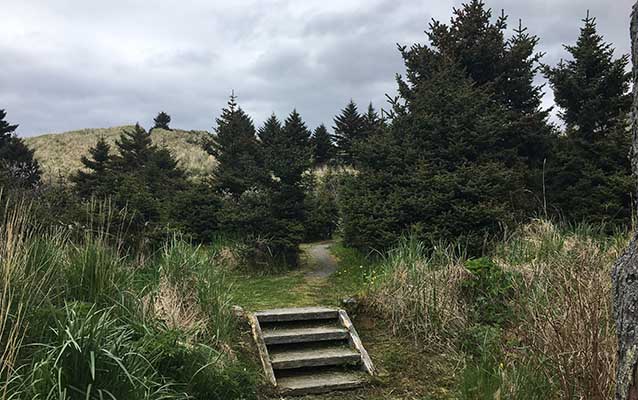Last updated: October 26, 2021
Place
Sitka Spruce Plantation National Historic Landmark

NPS/REHood
The Aleutians: An unlikely place for a tree farm
Unalaska Island and the Aleutian Islands chain is remarkable for its treeless landscape. It gives far-off views of tundra valleys, snowcapped mountain peaks, steaming volcano tops, and the deep blue Pacific Ocean.
This boundless vista unobstructed by tall trees is the site of the first afforestation project in North America. Different from reforestation—where tree cover is replaced—Russian colonizers experimented with afforestation, planting trees where none had stood before.
Russian Enterprise
In 1805 a Russian colony had settled on Unalaska. Desiring to be as self-sufficient as possible they planted spruce trees imported from Southeast Alaska, Picea sitchensis the Sitka spruce.
Being at the merging point of warm southern currents and cold arctic currents, the Aleutian Islands has earned its reputation as an astonishingly windy environment. You can expect rainfall for about 250 days of the year and strong wind gusts are common. Tree fossils have been found on the Aleutians, but the windy gales are unwelcoming to anything more than shrubby willow and the occasional conifer never reach more than 10 feet in height.
Twenty years after the first planting only 20 trees stood at the plantation. In 1975, only six of the original Sitka spruce were still growing but hundreds of small saplings surrounded them.
The Sitka Spruce Plantation National Historic Landmark today
Two hundred years after the first planting the spruce are still confined to a tiny plot within the Sitka Spruce Park that Unalaska enjoys as a town park with a small playground. Walking along a trail that winds through the remains of the plantation gives one the feeling of being in a forest. Benches overlook a small reflective pond.
Though treeless, the landscape cannot be called desolate. The Aleutian Islands span from the southern tip of the Alaska Peninsula 1,100 miles to Attu Island on the western end of the island chain. It is a popular destination for birders to catch a glimpse of northern species and migratory birds from all over the globe. You can also observe whales, sea otters, and other sea mammal species. Introduced animals include red and blue foxes and caribou. In the summer months, flowering plants, grasses, berries, herbage, and shrubs give the islands a glowing emerald hue.
A Russian tree farm and the history of Alaska and the United States
The Russian colonizers and tree planters did not settle a derelict land. Russian explorers describe their relationship with Alaska Natives in journals and reports.
Archeological evidence attest to seafarers colonizing the Aleutians and the Gulf of Alaska at least 9,000 years ago. The rising ocean that submerged the Bering Land Bridge has probably drowned the most ancient human settlements in the Alaska.
Their descendants, Unangax families (commonly referred to as Aleut), prosper in Alaska today.
The National Historic Landmark is about two and a half miles from Holy Ascension of Our Lord Cathedral National Historic Landmark. A Russian Orthodox Church, founded in 1826 then rebuilt in 1894, with a strong congregation on Unalaska and Amaknak Islands. The Sitka Spruce Plantation National Historic Landmark is also within the Dutch Harbor Naval Operating Base & Fort Mears, U.S. Army National Historic Landmark, which commemorates the World War II operations on the islands, including the evacuation of hundreds of U.S. citizens from the Aleutian Islands.
